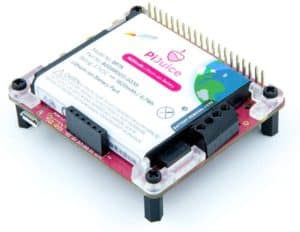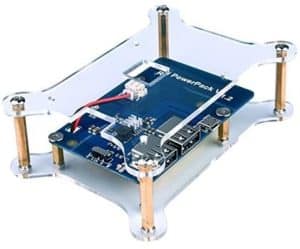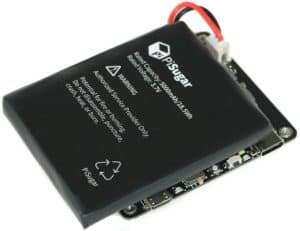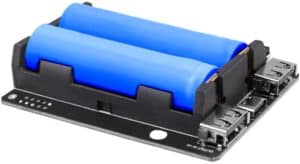Best Raspberry Pi Battery in 2025
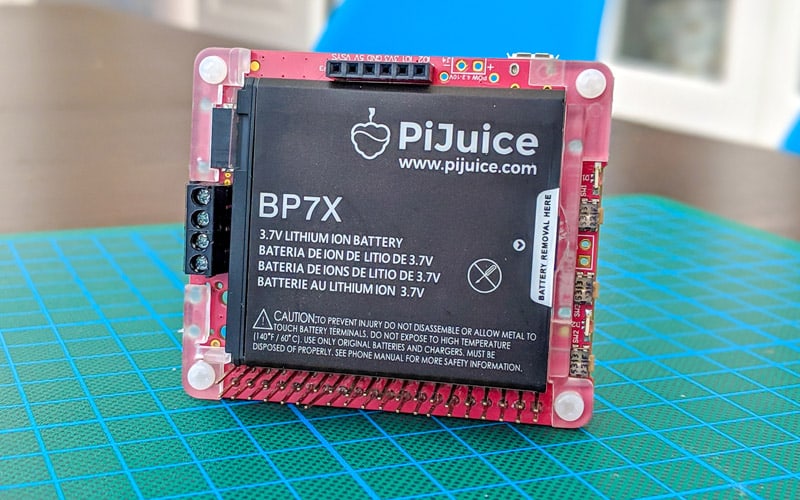
Table of Contents
One of the main benefits of the Raspberry Pi is it’s small form factor that makes this versatile mini-PC particularly applicable to a variety of uses. But as with any electronic device, the Raspberry Pi requires a power source.
In most cases, this involves slotting a power supply into the Type-C port of the Raspberry Pi or, alternatively, using a USB cable to pair it with a chunky power bank. Neither solution is ideal. With a power supply, the Pi is tethered, affecting how and where it can be used. Combined with power banks, which are often considerably larger than the Pi itself, the setup becomes bulkier and more challenging to incorporate into projects that require a small footprint.
This is where small form factor battery packs tailor-made for and similarly sized to the Raspberry Pi shine. They are a convenient, discreet way to power a Raspberry Pi, offering untold levels of freedom of movement and placement, which are needed for the most ambitious and innovative projects.
Today, we’re focused on shining a spotlight on the best Raspberry Pi battery packs currently on the market.
Products at a Glance
How We Picked
As with any battery, battery life and efficiency are key considerations. These are the best metrics to find the most reliable Raspberry Pi battery packs money can buy and largely guided our trawl through what’s out there.
We also factored in whether a battery uses 18650 rechargeable Lithium-Ion batteries that adopt the standard form factor of consumer three-lettered batteries (AA, AAA, etc.), or make use of an integrated, rechargeable Lithium-Ion battery pack, as well as how it pairs with the Pi, whether that’s through the GPIO or a USB port.
Raspberry Pi compatibility, specifically whether they are suited to the most recent RPi 4 and older models and the smaller form factor Zero variants, was also something we considered.
After careful consideration, we slimmed down our recommendations to five Raspberry Pi batteries that we are confident will deliver where it matters for all and any project that favors a mobile power source or UPS failsafe. Read on to find out why these batteries caught our attention, as well as a brief buyer’s guide-style ‘Things to Consider’ section sharing several key factors to consider when shopping for the best Raspberry Pi battery for your needs.
Product Reviews
- 4 to 6 hours of battery life
- GPIO pass-through
- Compatible with all Raspberry Pi models
- Hot-swappable battery bracket
- Pricey
The PiJuice HAT is one of if not the most sophisticated Raspberry Pi battery packs on the market today, mainly due to a clever integrated design, good battery life, and broad compatibility with both Raspberry Pi models and add-ons.
The design incorporates the battery itself alongside a purpose-built platform PCB. These connect easily and solidly to any Raspberry Pi model (including the small form factor Zero series) via standoffs and screws. The construction is of the highest quality, and the price tag, which isn’t cheap by battery pack standards, feels entirely warranted. This is a solid and well-built part through and through.
The PiJuice HAT connects to the Raspberry Pi GPIO pins via a stacking header that acts as a pass-through. The battery only uses five GPIO pins (power and i2C), leaving the rest for other add-on boards. Additionally, there’s a header on the PCB to link up an external battery and another header to pair it with a solar panel for uninterrupted use. With a bit of tinkering, the PiJuice HAT can be set up to run untethered to a plug socket or wired power source indefinitely, positioning it as an ideal option for outdoor projects.
The Lithium-Ion battery boasts 1820 mAh, which equates roughly to 4 to 6 hours of sustained use. Additionally, the battery sits atop the PiJuice PCB on a bracket of sorts, which means it can easily be swapped out for a beefier option with more battery life, or you can use two batteries – one powering the Pi while the other charges, ideal for projects that need to be on 24/7. The battery charges either via the on-PCB micro USB port or through the Raspberry Pi’s micro USB port.
It also the attention to detail that impresses, notably the feature set integrated into the PCB – an on-board real-time clock, an integrated micro-controller chip that delivers power management functionality such as low power mode/intelligent startup/auto soft shutdown, two RGB LEDs for monitoring, three programmable buttons, and an intelligent on-board on/off switch.
The PiJuice HAT is the uncontested king of the Raspberry Pi battery pack. If you can squeeze it into your project’s budget, there’s no better option currently available.
- 3800 mAh Lithium Ion battery
- Double USB output
- Two layer acrylic platform for the battery and Raspberry Pi
- Full GPIO access
- Larger footprint than other available battery packs
In the runner-up spot, we have the kuman Lithium Battery Pack Expansion Board. Another well-designed battery solution, this one makes our list for its low asking price, two-layer platform design, and excellent battery life.
As for the battery itself, it’s a Lithium-Ion block with 3800 mAh, capable of powering a Pi under average loads for up to nine hours on a single charge. It charges via a USB Type-C port mounted on the PCB. The PCB itself pairs with the Raspberry Pi via one of the dual USB ports, which then connects to the Pi’s standard USB Type-C power port, leaving the GPIO fully accessible for add-ons. Conveniently, the other USB output can integrate an add-on that requires power, such as a touchscreen or standard LCD.
Baked into the kuman Lithium Battery Pack Expansion Board is broad Raspberry Pi compatibility, so whether your running an older-generation RPi 1/2/3 or the newer 4, this battery pack works just as well.
One of the reasons it didn’t quite make it to the top spot on our list is that the PCB board doesn’t have the same spread of useful power management features as the PiJuice HAT. However, it still boasts rudimentary battery monitoring, a pair of charging/output indicator LEDs, a physical on/off switch, and an automatic power output function that detects when the Pi is on or off.
Another point to consider is the larger footprint, partly due to the two-layer acrylic platform. The solution is excellent, sized to match the Raspberry Pi, solid, and easy to install via the provided standoffs and screws. But, it is larger than the PJuice HAT, for example, which may not work well with projects that require a more discreet setup.
Where it does trump the PiJuice HAT is price. The kuman Lithium Battery Pack Expansion Board sells for substantially less than what you can expect to lay down for the PiJuice HAT, making it a strong pick for those on a tighter budget.
Finally, it’s worth noting that kuman Lithium Battery Pack Expansion isn’t a genuine UPS solution, as removing a mains-connected power supply causes a hard reboot of the Raspberry Pi. As such, we view this one as a solution to turn your Pi into a portable device rather than a backup power solution.
- 5000 mAh, 8 to 10 hours battery life
- Low profile solution
- GPIO pass-through
- Programmable button
- Easy mounting to Raspberry Pi
- On/off switch not suitable for cases
- Manual turn on required after power loss and battery drain
With a battery life that can push past 10 hours of average Pi use, the Pisugar2 Pro makes our list as the top choice for projects requiring a large capacity battery and a robust UPS solution.
The Pisugar2 Pro features a 5000 mAh Lithium-Ion battery connected to a PCB for an overall low profile footprint that conforms roughly to the size of the Raspberry Pi in length and width. The design is extremely thin compared to other Raspberry Pi battery pack options, which scores points for projects that favor a slim, compact setup.
The Pisugar2 Pro mounts to the Raspberry Pi via four screws fed from the Pi into the battery pack’s PCB. The connection is made via a pogo-pin that touches the underside of the GPIO, acting as a GPIO pass-through and leaving the top header open for expansion with HATs and add-ons. A magnet mounted on the PCB ensures a firm connection to the Pi’s GPIO underside.
The board itself features an I2C interface for battery monitoring/management (automatic shutdown function, wake up function, and charge/drain cycling to extend the battery’s lifespan) and features an on-board real-time clock with its own backup battery, timed power on modes, and a programmable button that can be customized to run scripts or trigger shutdown based on whether you press it once, twice, or keep it pushed down.
One major issue we have with the Pisugar2 Pro is the positioning of the on/off switch mounted on the PCB, which makes it virtually impossible to house the Pi and the battery pack in a case if you want easy access to the switch. Additionally, while the Pisugar2 Pro performs well as a UPS, switching effortlessly over to battery power when the adapter is disconnected/loses power, you’ll need to manually switch the battery off then on again once the battery has fully drained even if you reconnect a mains-connected adapter.
- Two USB outputs
- Copper mount/acrylic shield stack
- LED battery indicator
- Full GPIO access
- Low price
- 18650 batteries not included
Finally, the MakerHawk Raspberry Pi UPS Power Supply enters our list as one of the more interesting budget Raspberry Pi battery packs on the market, mainly due to a very affordable $30 price tag.
Instead of a Lithium-Ion battery pack, the MakerHawk Raspberry Pi UPS Power Supply uses two standard Lithium-Ion rechargeable batteries, specifically 18650 batteries.
Unfortunately, no 18650 batteries are included alongside the MakerHawk Raspberry Pi UPS Power Supply, so account for an extra $10 or so for a pair of batteries. As battery life mileage varies from manufacturer, we can’t give a firm number of how many hours you’ll get from two fully charged batteries, but four to six hours is a reasonable estimate.
The battery pack features a PCB board attached to your standard fare battery housing with two USB outputs (perfect for a touchscreen or display), LED battery indicators, and a power switch. This then pairs with the Raspberry Pi via a set of eight copper sticks and an acrylic platform. It’s not the most compact design, but it’s functional and easy to put together.
The battery pack feeds power to the Raspberry Pi through the Type-C on the pack and a standard USB port on the Pi. As such, the GPIO is fully accessible and can accommodate all manner of HATs.
Things to consider
Battery Life
Naturally, the first question that springs to mind when shopping for a battery for a Raspberry Pi or otherwise, is how many hours of use it offers. Mileage varies from model to model. The best way to get a sense of how much juice you can expect from a particular battery pack is to check the mAH count—the higher, the more battery life you can expect.
For example, the Pisugar2 Pro sports a 5000 mAh lithium battery capable of powering the Pi for anywhere from 6 to 10 hours depending on the frequency of use, application, and the presence of power-sapping peripherals such as a screen.
If long battery life is a crucial feature, we’d recommend spending a bit more on a battery pack with a better lithium battery. It’s also worth considering how long it takes a battery to reach a full charge when plugged in, especially if you are a heavy user.
Setup and Connectivity
Raspberry Pi batteries pair with the Pi in two main ways.
The first is via the Pi’s GPIO port, the 40-pin connector designed to house Raspberry Pi add-on modules, otherwise known as HATs. Batteries that use this method tend to be designed to sit flush with the RPi, which can be crucial for projects that favor a small battery footprint. Additionally, battery manufacturers tend to tool the battery to include a GPIO pass-through, not to block off access to the GPIO and limit project potential. Other GPIO setups connect to the bottom of the GPIO, leaving access to the top pins open.
The second method uses one USB port mounted on the Pi to connect to the Raspberry Pi. A Type-C port sits on the battery, which then feeds power to the RPi. Others will mix up the arrangement and run a USB cable from a standard USB port on the battery pack to the USB Type-C power port on the Raspberry Pi.
Battery packs also commonly include extra USB ports to pair up peripherals such as touchscreens. You’ll also find a USB Type-C port for charging the battery.
Our Verdict
If money is no object, it’s hard to go wrong with the PiJuice HAT. It’s the complete Raspberry Pi battery package with good battery life, a well-thought-out integrated design, and a wealth of power management features.
Another excellent choice, the kuman Lithium Battery Pack Expansion Board delivers up to nine hours of independent power for the Raspberry Pi in a two-layer acrylic platform. It falls on the larger side, but if compactness isn’t an imperative, there are worse ways to power a Raspberry Pi free of a mains connection.
If long battery life is essential, we suggest the Pisugar2 Pro. With up to 10 hours of battery life, a low profile footprint, GPIO pass-through, and easy mounting to the Pi, the pack is only let down by a minor UPS functionality issue.
Lastly, our top budget crown goes to the MakerHawk Raspberry Pi UPS Power Supply. You’ll need to source 18650 batteries, but beyond that, there’s everything here to deliver reliable and sustained power to portable Raspberry Pi projects on the cheap.
With that, we’ll wrap up our product guide to the best Raspberry Pi battery packs. The comments section below is open for any questions, suggestions, or concerns you may have.

